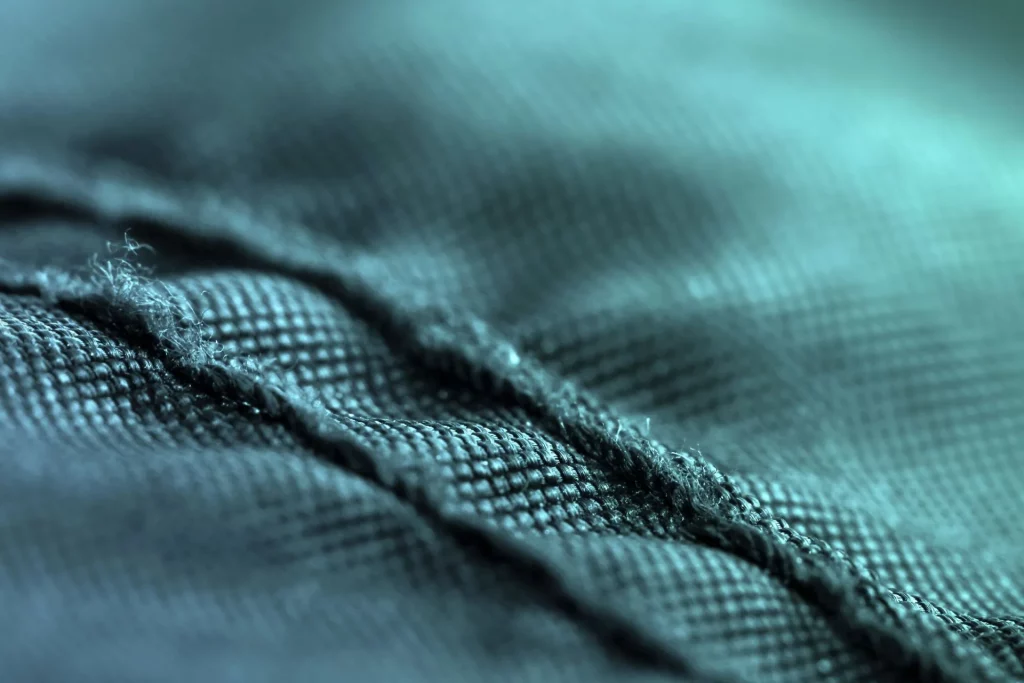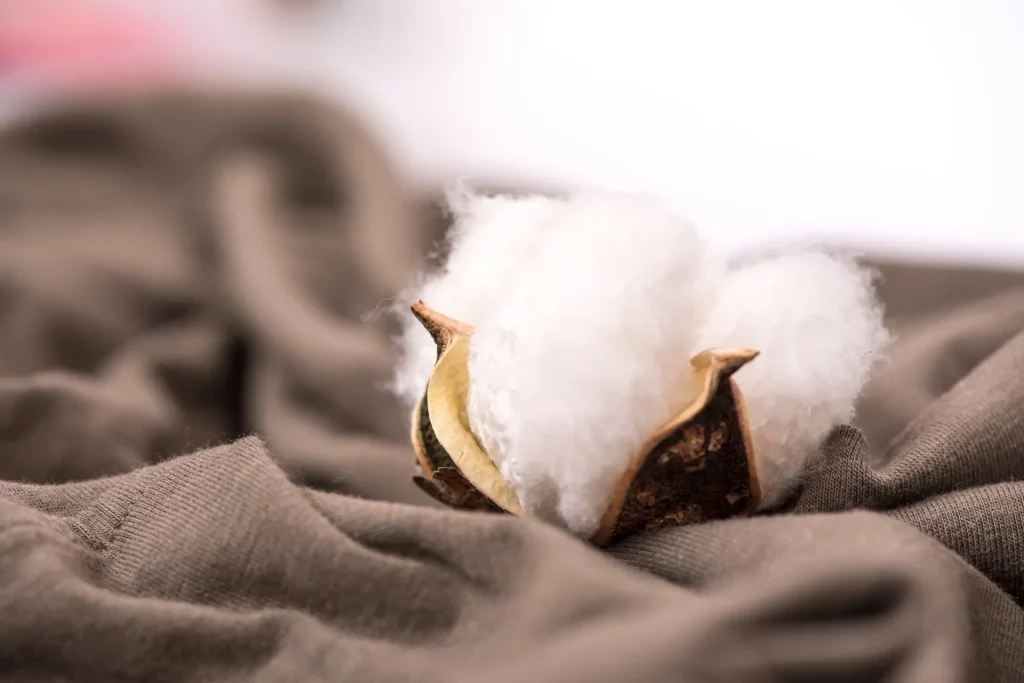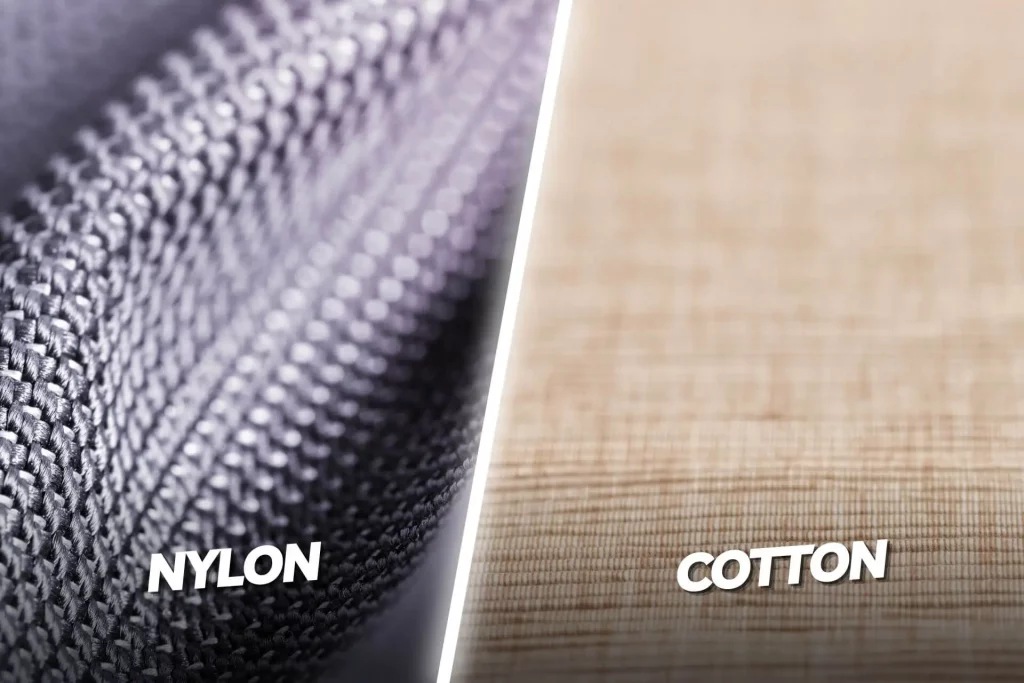Cotton has been there since the beginning of time, and throughout history, it has often demonstrated its value. Although nylon hasn’t been around for as long as other fabrics, many individuals still like to wear it when participating in particular activities. It is in the process of demonstrating its value.
Anybody, including a young infant, may recognize the most significant distinction. Cotton is a natural fabric from a plant cultivated in many countries. Nylon is entirely artificial and may most likely be produced in several countries. To produce this fiber, the majority of nations do not require the importation of oil.
Continue reading our post, and you will learn more about the distinctions between these two types of cloth. It provides a wealth of information on both subjects and explains how and why the two types of cloth do not perform the same functions in the fashion industry.
Table of Contents
What is Nylon?

Nylon is a synthetic fiber that combines dicarboxylic acid and diamine throughout manufacturing. Fabrication often makes extensive use of this. Leggings, stockings, swimsuits, and athletic wear are just a few of the outfits that may be crafted from nylon fabric.
In addition, it is utilized in manufacturing parachutes, bags, ropes, carpets, tires, tents, and other goods of a similar kind. Working at the DuPont Experimental Station, Wallace Carothers is credited with inventor nylon. During World War II, there was a severe shortage of natural fibers such as silk and cotton, which led to the rapid rise in the popularity of this material.
Because of its low absorbency rate, nylon is an excellent choice for constructing swimwear and sporting apparel. In addition to this, it is less expensive than natural fibers such as cotton and silk, and it is simple to care for. Even after being put through the washing machine, it does not quickly develop wrinkles and creases and keeps its original form. In addition to this, it is resistant to strains. Nylon is a fabric that is both resilient and robust.
Natural fabrics outshine synthetic fibers in terms of performance, breathability, and odor control. If you want to verify these differences, you can refer to our comparison between merino wool and synthetic fabrics.
Properties of Nylon:
Strength and durability: Nylon is a material that excels in both strength and durability due to its composition. Its high tensile strength indicates it can withstand significant tugging and stretching before breaking. As a result of its resistance to abrasion as well as wear and tear, it is an excellent choice for use in products that must be hardy and long-lasting.
Elasticity: Nylon possesses a high degree of elasticity, which indicates that the material can be stretched and then returned to its original shape without reducing its strength or shape. Because of this feature, it may be utilized in various applications, including stockings, athletic wear, and other forms of apparel.
Water resistance: Nylon is resistant to water and moisture, making it an ideal choice for use in applications where the material may come into contact with water or other liquids, such as raincoats or outdoor gear. Nylon’s resistance to water also makes it ideal for use in applications where the material may come into contact with water or other liquids.
Heat resistance: Since nylon can tolerate high temperatures without melting or otherwise deteriorating, it is well suited for high-temperature applications, such as those found in electrical devices and automobile components.
Chemical resistance: Nylon is resistant to various chemicals, including oils, solvents, and alkalis. This property makes it an excellent choice for use in industrial settings. Because of this feature, it may be utilized in various industrial applications, including hoses and tubing.
Lightweight: Nylon is a lightweight material, which makes it perfect for use in situations where weight is a problem, such as backpacks and luggage. Because of its modest weight, nylon is a strong and durable material.
Dyeability: Nylon is extremely dyeable, which means that it may quickly take on the color of a wide variety of colors because of its high dyeability. Because of this feature, it is beneficial in applications in which color is crucial, such as textiles and garments.
Pros of Nylon:
- As nylon is so elastic, it can be stretched up to 100% of its original length without snapping. This characteristic makes it the perfect fabric for clothing that fits snugly or moves with the body.
- Nylon wicks moisture away from the body and dries quickly, making it a great material for fitness and outdoor clothes.
- Nylon is suitable for everyday things since it is simple to maintain and frequently machine washable.
- Nylon has several uses in industry, including ropes, conveyor belts, parachutes, household textiles, automobile components, and garments.
- Nylon is a good material option for outdoor applications since it is resistant to mildew formation and is repulsive to many insects.
Cons of Nylon:
- Nylon is susceptible to heat damage because it has a low melting point. High temperatures, such as those produced by ironing or exposure to the sun, can harm nylon.
- Nylon is susceptible to static electricity, making clothing stick to the body or drawing lint and dust.
- When exposed to UV rays, nylon deteriorates, which can cause strength loss and color fading in outdoor applications.
- Because petroleum is a non-renewable resource, it is used to make nylon, which raises questions about sustainability and reliance on fossil fuels.
What is Cotton?

Cotton is one of the natural fibers utilized in the textile industry to the greatest extent. Cotton is derived from the pods of the cotton plant and is composed of cellulose, pectin, water, and wax. Cotton fibers may be spun into yarn. Cotton is used in producing a wide variety of clothing, including but not limited to shirts, skirts, t-shirts, blankets, robes, pants, and other items.
This is the perfect cloth for warm areas since it is airy, lightweight, and supple. Cotton clothing can keep the user cool throughout the day. As a result, it may be fashioned into indoor and outdoor clothing that is airy and casual. Cotton can not irritate or create allergies to the skin because it is manufactured from natural raw materials; thus, even persons with the most sensitive skin may wear cotton.
Properties of Cotton:
Breathability: Since cotton fibers enable air to move around them readily, it is renowned for having good breathability. Cotton’s ability to regulate body temperature makes it pleasant to wear in various climates.
Softness: Comfortable against the skin because of its naturally smooth texture, cotton provides a pleasant feel. Clothing, beds, and other goods that call for a delicate touch frequently employ it.
Absorbency: Cotton is incredibly absorbent, which allows it to absorb fluids like perspiration or water swiftly. Because of its quality, it is a well-liked option for towels, robes, and sportswear.
Hypoallergenic: Cotton is a hypoallergenic material, making it less likely to irritate or induce allergic responses in people. As a result, those with sensitive skin or allergies can use it.
Biodegradable: Cotton is a natural fabric that decomposes over time when disposed of, lessening its impact on the environment.
Easy to dye: Cotton fabrics may be colored in various colors and designs because cotton fibers are simple to dye.
Limited elasticity: Cotton fibers are not very flexible, which makes them good at maintaining their form. This characteristic, however, may also be a drawback if clothing must stretch or adjust to the body’s motions.
Wrinkle-prone: Cotton is prone to wrinkles and may need to be ironed to keep its smooth appearance. Although certain cotton textiles may be treated to minimize creasing, doing so may change the fabric’s other characteristics.
Susceptible to shrinkage: Cotton clothing is susceptible to shrinking while washing, especially if heated up. It’s crucial to carefully follow the care recommendations for cotton goods to reduce shrinking.
Flammability: Cotton is combustible and readily ignites when it comes into contact with an open flame or much heat. Cotton clothing should never be worn close to heat sources or open flames.
Pros of Cotton:
- Cotton is well-known for being comfy and soft, which makes it a popular material for clothes and bedding.
- Cotton is breathable, allowing air to pass through and keeping you cool and dry in heated weather.
- Cotton is suitable for towels and other absorbent items since it can absorb up to 27 times its weight in water.
- Cotton is a wonderful option for sensitive skin because it is hypoallergenic and unlikely to trigger allergic reactions.
- Strong and long-lasting, cotton is a material that can resist repeated washings and use.
To ensure that your Egyptian cotton sheets last long and remain clean after washing, it is recommended to follow proven washing methods rather than using the wrong approach.
Cons of Cotton:
- When cotton is subjected to heat and water, it tends to shrink, which can be problematic when washing items.
- Cotton is prone to wrinkles, which can be challenging to iron out.
- Cotton materials fade with time, especially when exposed to sunshine.
- Care must be taken when washing and drying cotton to preserve its durability and quality.
- Cotton manufacturing is water-intensive, which can burden local water supplies in locations with a water shortage.
Is you’re experiencing shrinkage issues with your woolen apparel, we have tested and reviewed proven methods to restore your clothes and prevent further shrinkage.
Nylon or Cotton: Which Is More Breathable?

According to a fashion adage, the material becomes less breathable closer to the body. The adage applies to both cotton and nylon. Cotton is still more breathable than nylon, even when a portion is woven to be close to the body. One disadvantage of synthetic materials is that.
They can’t compete with cotton or other natural fibers in this area since they don’t breathe as effectively. Nylon is designed to be worn near the skin since it effectively wicks away moisture; nevertheless, it will make you feel hotter because of its tight threads.
Cotton is superior because it can be knitted or woven into varied weights, thicknesses, and textures and naturally breathes. While cotton takes care of how you appear after the games, nylon is more suited for activities like cycling, team sports, and swimming that require much physical mobility.
Is Cotton Warmer Than Nylon?
It seems sensible that cotton breaths readily won’t keep you as warm as other fibers. In this case, cotton needs layers to keep you as warm as nylon. While nylon can help you stay dry and wick away moisture, it does not let you dissipate heat or cool down while moving.
Cotton will absorb moisture from the rain and your perspiration, at which point it no longer functions as an insulator. The chilly air takes advantage of that and chills you by sneaking through your clothes.
The weave of nylon is often tighter than that of cotton. The tightness eliminates any pathways heat could have had to escape if the weave had been looser. Heat is nowhere else but close to your body without escape pathways. Nylon makes you hotter, which is only advantageous during the winter or at the gym.
Cotton vs. Nylon Cost:
This isn’t even truly a competition. Virtually all synthetic fibers are less expensive than natural ones. The only things that may alter this fact are the material’s thickness, how expensive it is to make, and how great the demand is.
Cotton costs more than nylon. Growing the plant takes longer than combining the chemicals required to manufacture nylon. Herbicides and insecticides are also very expensive. After all the manufacturing costs are considered, cotton processing can be time-consuming and complex.
Then, cotton is in high demand. Cotton has a vast supply and is often inexpensive to buy in different places, but it will still cost more since too many people want to wear that material.
The demand for nylon is not so high because it is more specialized, and only a small portion of clothing is made of it. Also, there is possibly more supply than demand for nylon. Too much nylon fabric is on the shelf to justify hiking the price.
Nylon vs. Cotton Webbing:
Few fabric alternatives were available to webbing makers before developing nylon and polyester. Silk and linen were too costly, and hemp had a poor image.
Nylon is the superior fabric in this group because it is more resilient, robust, and hard to break than cotton. While cotton serves a role in some types of netting, it will eventually wear out, especially after prolonged usage.
Nylon is the greatest alternative for this cloth since it can withstand strong use, pressure, and stress better than cotton. Cotton’s softness is what most people find so appealing, yet that softness cannot withstand the pressure that netting is subjected to.
Moreover, cotton splits readily, which is not a nice sensation when you are 10,000 feet in the air, and your only support is a parachute. You will appreciate that nylon made parachute rather than cotton.
Nylon vs. Cotton Thread:
The cotton thread takes colors quite well, one reason you might choose it over the nylon alternative. Not so much for nylon. You can wind up with a piece of clothing with two color tones that clash rather than match.
Nylon is tougher than cotton thread and has a longer lifespan aside from that. It holds up nicely and can withstand the abuse that everyday wear may dish out. Cotton may deteriorate simply due to the friction it experiences as you walk, sit, etc.
While stitching elastic textiles, nylon will then stretch. Not so much with cotton. Nylon cannot compare to the infinite variety of hues and the tenderness of cotton thread.
Cotton matches fabrics’ colors better than nylon does. The type of cloth you are sewing or mending will determine the type of thread you use. Although the cotton thread is resilient and adaptable, it does not expand well.
After that, if the clothing is wet, cotton may get tougher but lose durability. When nylon is wet, none of its lifespans is lost. Just pick the appropriate thread for the cloth you’re working with.
| Category | Cotton | Nylon |
|---|---|---|
| Production | Made from natural fibers that come from cotton plants | A synthetic fiber made from petroleum-based materials |
| Comfort | Soft, breathable, and hypoallergenic, making it suitable for sensitive skin. | Less breathable than cotton, but lightweight and quick-drying |
| Durability | Not as strong as nylon and tends to shrink, fade, and wrinkle | Stronger than cotton and maintains its shape, color, and strength over time |
| Water Resistance | Absorbs water and takes longer to dry | Resistant to water and dries quickly |
| Uses | Commonly used in clothing, bedding, and towels | Often used in outdoor gear, activewear, and swimwear |
| Environmental Impact | Biodegradable and renewable, but requires significant amounts of water and pesticides to grow | Non-biodegradable and made from non-renewable resources, but can be recycled and repurposed. |
| Cost | Generally less expensive than nylon | More expensive than cotton |
Frequently Asked Questions:
Are nylon underwear breathable?
Although some brands of nylon pants utilize unique materials or manufacturing methods to promote breathability and moisture-wicking capabilities, nylon pants are often less breathable than cotton or other natural fabrics. For improved breathability and comfort, picking cotton or other natural fibers is advised, especially for people with sensitive skin or prone to infections.
Can nylon be recycled?
Nylon can be recycled. The technique of recycling nylon entails dissolving nylon trash into the monomer from which new nylon goods may be made. Recycling nylon uses less energy and resources than creating new nylon, so it helps minimize waste and save resources. All recycling facilities do not accept nylon. Therefore, asking your local recycling program for detailed instructions is vital.
Is nylon a natural resource?
Nylon is not a resource derived from nature. Unlike other natural fibers, nylon is a synthetic fabric from petroleum-based ingredients. Since its introduction as a silk substitute in the 1930s, it has found widespread application in various goods, including clothes, carpets, and packaging materials. Despite not being a natural resource, nylon is made from non-renewable materials and greatly influences the environment throughout its lifespan.
Bottom Line:
Cotton, a very nice fabric, can be found virtually anywhere. Its adaptability is well-known, and it is not often expensive unless one purchase cotton of a higher quality than what is typically available. There is a time and a place for nylon, which is superior to polyester in some applications. But, it does not apply to every facet of life and will not replace cotton anytime soon.

